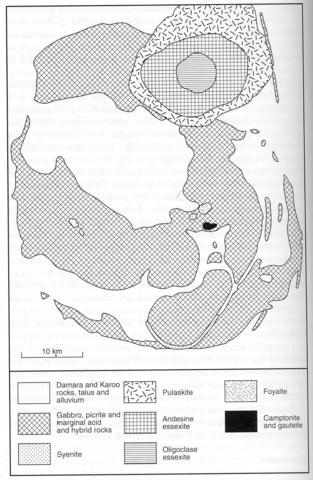stripes
The intrusive rocks of Okenyenya cover an area of about 20 km2 and form inselbergs rising from a plain of strongly folded Damara sediments and associated granites on which lie unconformably Karoo sediments. The last comprise coarse terrestrial rocks and they are preserved at localities along the northern, eastern and southern margins of Okenyenya where they dip away from the complex and are thermally metamorphosed. The complex has been mapped by Simpson (1954) and in more detail by Watkins and le Roex (1994) who present a structural reinterpretation of the occurrence. The rocks of the complex form two series: an earlier tholeiitic one grading mineralogically and chemically from olivine gabbro through ferrogabbros to silica-oversaturated rocks characterised by the presence of orthpyroxene, and a later alkaline series ranging from olivine gabbro, through essexite and pulaskite to foyaite, tinguaite and associated lamprophyric and alkaline dykes. The earlier series includes a marginal gabbro-picrite, which occupies a discontinuous dyke-like body on the eastern side of the complex, and gabbros of what were called the differentiated group by Simpson (1954), that form a broad arcuate outcrop in the southern part of the complex. The innermost rocks are troctolites in which alkali feldspar, hornblende and quartz appear in the outermost ferrogabbros. Much of the western part of the complex is occupied by a group of acid and hybrid rocks containing numerous xenoliths and consisting of plagioclase (An20-5), xenocrysts of more basic plagioclase (An34-25), microperthite, which is more plentiful than the plagioclase, myrmekite, hornblende, some with cores of ferroaugite, sometimes fayalitic olivine (Fa87), quartz, biotite and accessory apatite and zircon. The later alkaline series shows little continuous variation in chemical composition and mineralogy, although the core gabbro, which occupies an extensive area of high relief in the centre of the complex, is in places rhythmically layered. This gabbro consists of plagioclase with calcic cores (An80-70) and more sodic rims (An60-40), diopsidic pyroxene, sometimes altered to amphibole, a little olivine (Fa35-27), opaque minerals, biotite, apatite and occasional perthite, and in one area nepheline. The Okenyenya Berg, which is a distinct intrusive centre in the northeast of the complex, comprises alkaline rocks of the later series ranging from central essexites to a marginal pulaskite. The outer andesine essexite is chilled against the pulaskite and consists of andesine, orthoclase, nepheline, which is occasionally replaced by sodalite, and sometimes with dactylitic textures between the feldspars and feldspathoids, clinopyroxene, amphibole and olivine (Fa73-64). The centre of Okenyenya Berg is an oligoclase essexite of oligoclase (An20-15), orthoclase, nepheline and hastingsite, with sodalite in some rocks and accessory albite, analcime and calcite. The pulaskite is a leucocratic rock of alkali feldspar. often perthitic, sporadic nepheline, a little sodalite, salitic pyroxene, amphibole and biotite. Two small circular bodies of foyaite occur within the core gabbro, the rock consisting of phenocrysts of orthoclase and nepheline in a groundmass of orthoclase, albite, nepheline, sodalite, minor analcime, calcite and cancrinite and sparse microphenocrysts of titanaugite and ferrohastingsite. Towards the surrounding gabbros the foyaite becomes heterogeneous with occasional streaks and patches of melteigite. Syenites and quartz syenites form sheets, particularly in the southwest of the complex, and these have been investigated in detail by Watkins and le Roex (1991) who give petrographic details, rock and mineral chemistry and an interpretation which, in this area in particular, differs significantly from that of Simpson (1954). Dykes occur throughout the complex, but are particularly numerous in the southeast, and include bostonite, sodalite tinguaite, camptonite, including a variety referred to gauteite which forms a small stock, alnoite, with fresh melilite, monchiquite and melanephelinite. Analyses of all rock types and a range of minerals are given by Simpson (1954), and numerous analyses, including Sr, Nd and Pb isotope data, will be found in le Roex and Lanyon (1998).
LE ROEX, A.P. and LANYON, R. 1998. Isotope and trace element geochemistry of Cretaceous Damaraland lamprophyres and carbonatites, northwestern Namibia: evidence for plume-lithosphere interactions. Journal of Petrology, 39: 1117-46.MILNER, S.C., LE ROEX, A.P. and WATKINS, R.T. 1993. Rb-Sr age determinations of rocks from the Okenyenya igneous complex, north-western Namibia. Geological Magazine, 130: 335-43.SIMPSON, E.S.W. 1954. The Okenjeje igneous complex, South-West Africa. Transactions of the Geological Society of South Africa, 57: 125-73.WATKINS, R.T. and LE ROEX, A.P. 1991. Petrology and structure of syenite intrusions of the Okenyenya igneous complex. Communications of the Geological Survey of Namibia, 7: 55-70.WATKINS, R.T. and LE ROEX, A.P. 1994. A reinvestigation of the Okenyenya igneous complex: a new geological map, structural interpretation and model of emplacement. Communications of the Geological Survey of Namibia, 9: 13-21.WATKINS, R.T., MCDOUGALL, I. and LE ROEX, A.P. 1994. K-Ar ages of the Brandberg and Okenyenya igneous complexes, north-western Namibia. Geologische Rundschau, 83: 348-56.

